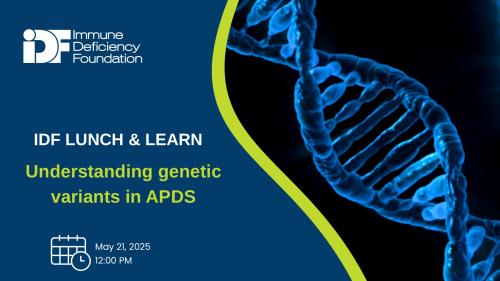
-
Understanding primary immunodeficiency (PI)

Understanding PI
The more you understand about primary immunodeficiency (PI), the better you can live with the disease or support others in your life with PI. Learn more about PI, including the various diagnoses and treatment options.
-
Living with PI
-
Addressing mental health
-
Explaining your diagnosis
- General care
- Get support
- For parents and guardians
-
Managing workplace issues
- Navigating insurance
-
Traveling safely

Living with PI
Living with primary immunodeficiency (PI) can be challenging, but you’re not alone—many people with PI lead full and active lives. With the right support and resources, you can, too.
-
Addressing mental health
-
Get involved

Get involved
Be a hero for those with PI. Change lives by promoting primary immunodeficiency (PI) awareness and taking action in your community through advocacy, donating, volunteering, or fundraising.
-
Advancing research and clinical care
-
Research Grant Program
-
Consulting immunologist
-
Diagnosing PI
-
Getting prior authorization
-
Clinician education
-
Survey research
-
Participating in clinical trials

Advancing research and clinical care
Whether you’re a clinician, researcher, or an individual with primary immunodeficiency (PI), IDF has resources to help you advance the field. Get details on surveys, grants, and clinical trials.
-
Research Grant Program
Individuals with primary immunodeficiencies (PIs) and their healthcare providers may not pursue genetic testing for a variety of reasons. Yet, it can be a powerful tool for confirming (or ruling out) a diagnosis. For those who get definitive information from it, which certainly isn’t everyone, genetic testing can inform everything from clinical management to decisions about family planning.
PIs are caused by changes, or variants, in a person’s DNA. Four nucleotides make up DNA: adenine (A), thymidine (T), guanine (G), and cytosine (C). The order of these nucleotides, or the DNA "sequence," encodes instructions for making proteins, cells, and organs, similar to how specific sequences of letters form words, sentences, and paragraphs. Genetic testing for PI looks for variants in a person’s DNA sequence that are most likely to explain their condition.
Reasons people don’t get tested
Their condition’s genetic cause is unknown
Some of the most common PIs are antibody deficiencies like common variable immune deficiency (CVID) without known genetic causes. Often, healthcare providers are skeptical of genetic testing for people with these diagnoses because they think testing is unlikely to provide any information.
However, the most recent classification of PIs lists variants in 23 genes that cause CVID-like disorders. It is impossible to determine whether someone with a CVID diagnosis has one of these conditions or not without genetic testing.
Why does it matter if someone has CVID or a CVID-like disorder? Some of these disorders, like activated PI3K delta syndrome (APDS), have specific treatments or different risks for complications than CVID. It’s important to test for them if only to rule them out.
The outcome won’t affect clinical management or treatment
Another barrier to genetic testing is the belief that the outcome will not affect clinical management or treatment for a particular person. In fact, in a study conducted by the Jeffrey Modell Foundation, clinical management and/or treatment changed for more than 35% of individuals with a clinical PI diagnosis who underwent panel testing. That same study found other benefits to genetic testing as well, including enabling more informed family planning decisions and identifying relatives at risk of PI or who could be genetic carriers.
Finally, having a genetic diagnosis may not affect the current course of treatment or clinical management, but it could determine whether someone is a candidate for emerging therapies or whether they are eligible for clinical trials.
Cost
The cost of genetic testing is a significant factor in whether people choose to get tested or not. Without insurance, genetic tests cost anywhere from $100 to several thousand dollars, depending on their complexity. Insurance companies will cover genetic testing if they deem it medically necessary, although the testing typically requires prior authorization.
In addition, there are programs that offer free genetic testing to certain individuals, such as NavigateAPDS and PATH4WARD. The Jeffrey Modell Foundation also offers free genetic testing for anyone suspected to have PI through its Jeffrey’s Insights program, which is available to clinicians at any of the 400+ institutions in the Jeffrey Modell Centers Network (JMCN).
What (typical) genetic testing can miss
Like any medical test, genetic testing has technical limits, as well as limits related to how laboratories analyze the results. For example, some variants involve large chunks of DNA rather than single-letter changes or small insertions or deletions in a gene. These structural variants (SVs) are difficult to pick up and are not routinely included in data analysis. Less common types of genetic testing like chromosomal microarrays or long-read sequencing are better suited to detecting SVs. Researchers are also working on specialized analysis to look for SVs specifically.
Another example is somatic mosaicism. Somatic mosaicism describes when cells from the same individual have different DNA sequences. Dr. Megan Cooper identified TLR8 GOF, a relatively new PI, largely from patients who were mosaic for TLR8 gene variants. All of them had the variant in less than 30% of their cells. While somatic mosaicism can be detected with the technology used in standard genetic testing, it is very easy to miss or ignore during data analysis. Typically, specific analysis tools designed to catch mosaicism have to be used.
Until researchers understand the genetic basis of every type of PI and overcome all of the technical challenges of capturing every type of variant, genetic testing won’t give everyone answers. But even if you don’t receive a genetic diagnosis from it, testing may be worthwhile for you.
Clinician Finder
IDF maintains a database of clinicians who specialize in treating PI. Use our tool to find clinicians across several medical specialties near you.
Find a providerTopics
This page contains general medical and/or legal information that cannot be applied safely to any individual case. Medical and/or legal knowledge and practice can change rapidly. Therefore, this page should not be used as a substitute for professional medical and/or legal advice. Additionally, links to other resources and websites are shared for informational purposes only and should not be considered an endorsement by the Immune Deficiency Foundation.
Related resources
Sign up for updates from IDF
Receive news and helpful resources to your cell phone or inbox. You can change or cancel your subscription at any time.





The Immune Deficiency Foundation improves the diagnosis, treatment, and quality of life for every person affected by primary immunodeficiency.
We foster a community that is connected, engaged, and empowered through advocacy, education, and research.
Combined Charity Campaign | CFC# 66309




